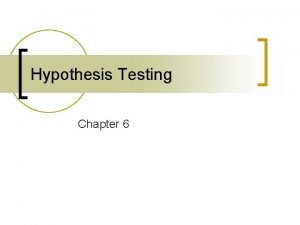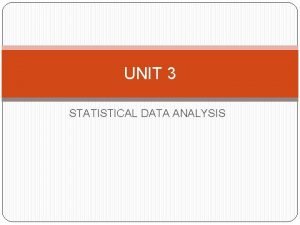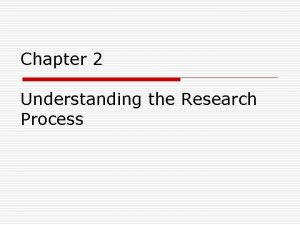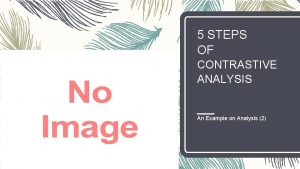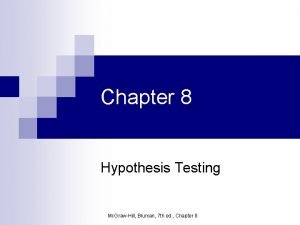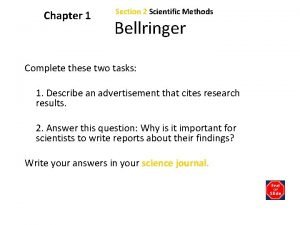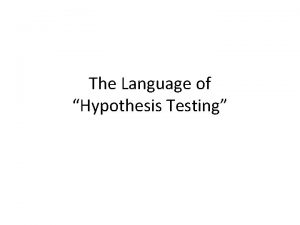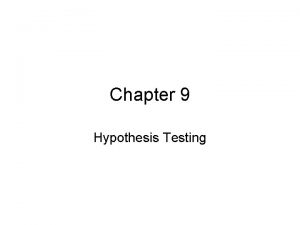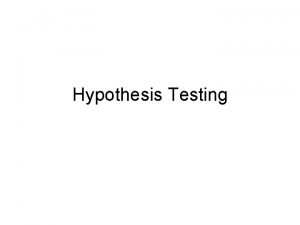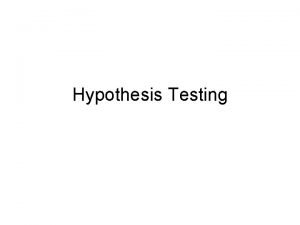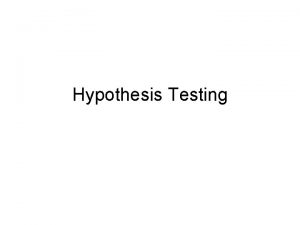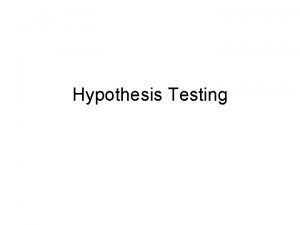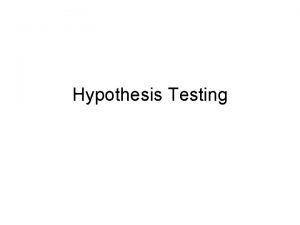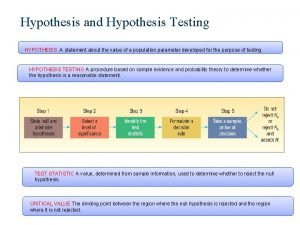Hypothesis Testing Chapter 6 Steps for Conducting Scientific














- Slides: 14

Hypothesis Testing Chapter 6

Steps for Conducting Scientific Research Step 1: Formulate a hypothesis Higher temperatures cause people to be more irritable Step 4: Report the results Step 2: Design a study Step 3: Collect & analyze data

Study Design This study will examine the effects of temperature on irritability. Subjects will be randomly assigned to one of three temperature conditions (low [70 o-72 o], moderate [80 o 82 o], or a high [90 o-92 o] temperature room). While in the room an assistant will irritate the subjects. Subjects will then complete an irritation scale.

Hypotheses The Study Hypothesis Ha: The amount of irritation subjects report will be significantly different among the three temperature conditions. The Null Hypothesis Ho: There will be no significant differences in the amount of irritation reported by the subjects among the three temperature conditions.

Sampling from the Population Sample

Operationalize and Measure Variables n Independent Variable: Temperature ¡ 3 Conditions n n Low (70° - 72°) Medium (80° - 82°) High (90° - 92°) Condition #1 Condition #2 Condition #3 Dependent Variable: Irritation ¡ Operationalized as ratings of irritation in response to assistant n Scale included in Appendix of paper

Irritation Scale During the experiment, how much did the assistant make you feel the following: Not at All A Little Bit Moderately Quite a Bit Extremely irritated or annoyed? 1 2 3 4 5 furiously angry? 1 2 3 4 5 mad? 1 2 3 4 5 so angry you felt like hitting the assistant? 1 2 3 4 5

Creating Scale Scores Subject Condition Item 1 Item 2 Item 3 Item 4 Mean Score 1 3 3 4 5 3 3. 75 2 2 2 3 2. 5 3 1 1 2 1. 5 Subject Condition Mean Irritation Score 1 3 3. 75 2 2 2. 5 3 1 1. 5

Describing the Data x=4 s =. 5 3 4 Condition 3 x=3 s =. 5 5 2 n = 15 Condition 2 Condition 1 n = 15 x=2 s =. 5 1 2 3 3 4 n = 15

Hypothesis Testing x=4 s =. 5 x=2 s =. 5 1 n 2 3 3 4 5 What could cause the difference in ratings between condition 1 and condition 3? ¡ Chance n n ¡ ¡ error individual differences not evenly distributed Confounds The independent variable (treatment)

Did the Results Occur by Chance? The treatment effect F-ratio = Between groups variance + Within groups variance Variation due to chance (error). Typically caused by individual differences in participants By controlling within-group variation, scientists can isolate the effects of the independent variable on the dependent variable (between-groups variance).

Inferential Errors True state of affairs Chance is responsible Null hypothesis decision Fail to reject Reject Chance is not responsible Correct “acceptance” Type II error Type I error Correct rejection

Presenting Tabular Results Table 1 Analysis of Variance for Irritation Source df SS MS F p Irritation(I) 1 640 25. 41 . 001 S within group error 36 94 2. 61 __ __

Presenting Graphic Results (F = 5. 0, p <. 05)
 Six steps of hypothesis testing
Six steps of hypothesis testing Steps in hypothesis testing ppt
Steps in hypothesis testing ppt Steps in hypothesis testing ppt
Steps in hypothesis testing ppt Define extraneous variable
Define extraneous variable Steps in conducting evaluation
Steps in conducting evaluation Contrastive analysis procedures
Contrastive analysis procedures Trevor sofield
Trevor sofield Chapter 8 hypothesis testing
Chapter 8 hypothesis testing Chapter 7 hypothesis testing with one sample answers
Chapter 7 hypothesis testing with one sample answers What is the null hypothesis
What is the null hypothesis Developing null and alternative hypothesis
Developing null and alternative hypothesis Null and alternative hypothesis statistics
Null and alternative hypothesis statistics Nebular hypothesis and protoplanet hypothesis venn diagram
Nebular hypothesis and protoplanet hypothesis venn diagram Scientific method bellringer
Scientific method bellringer The language of hypothesis testing
The language of hypothesis testing
